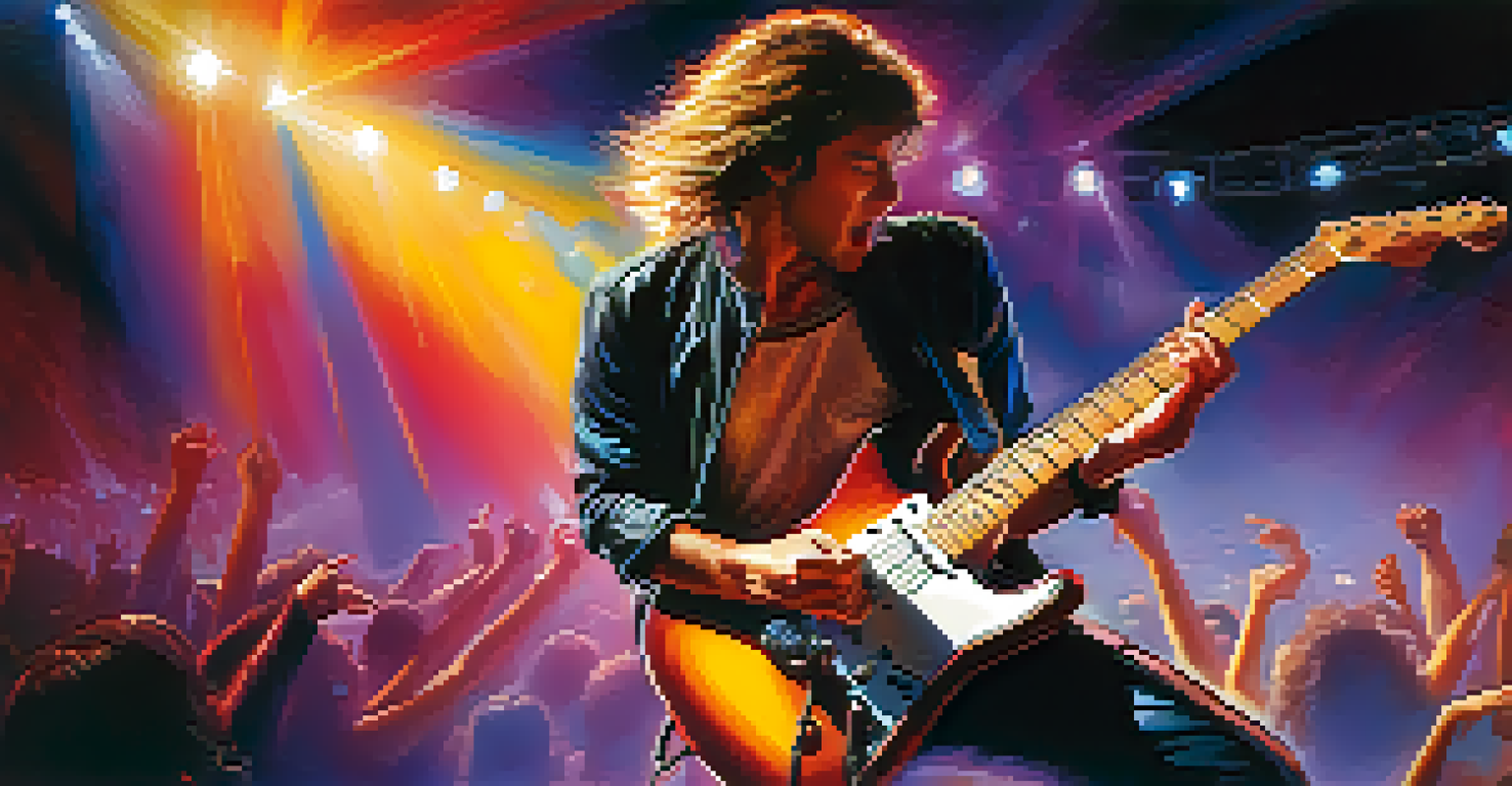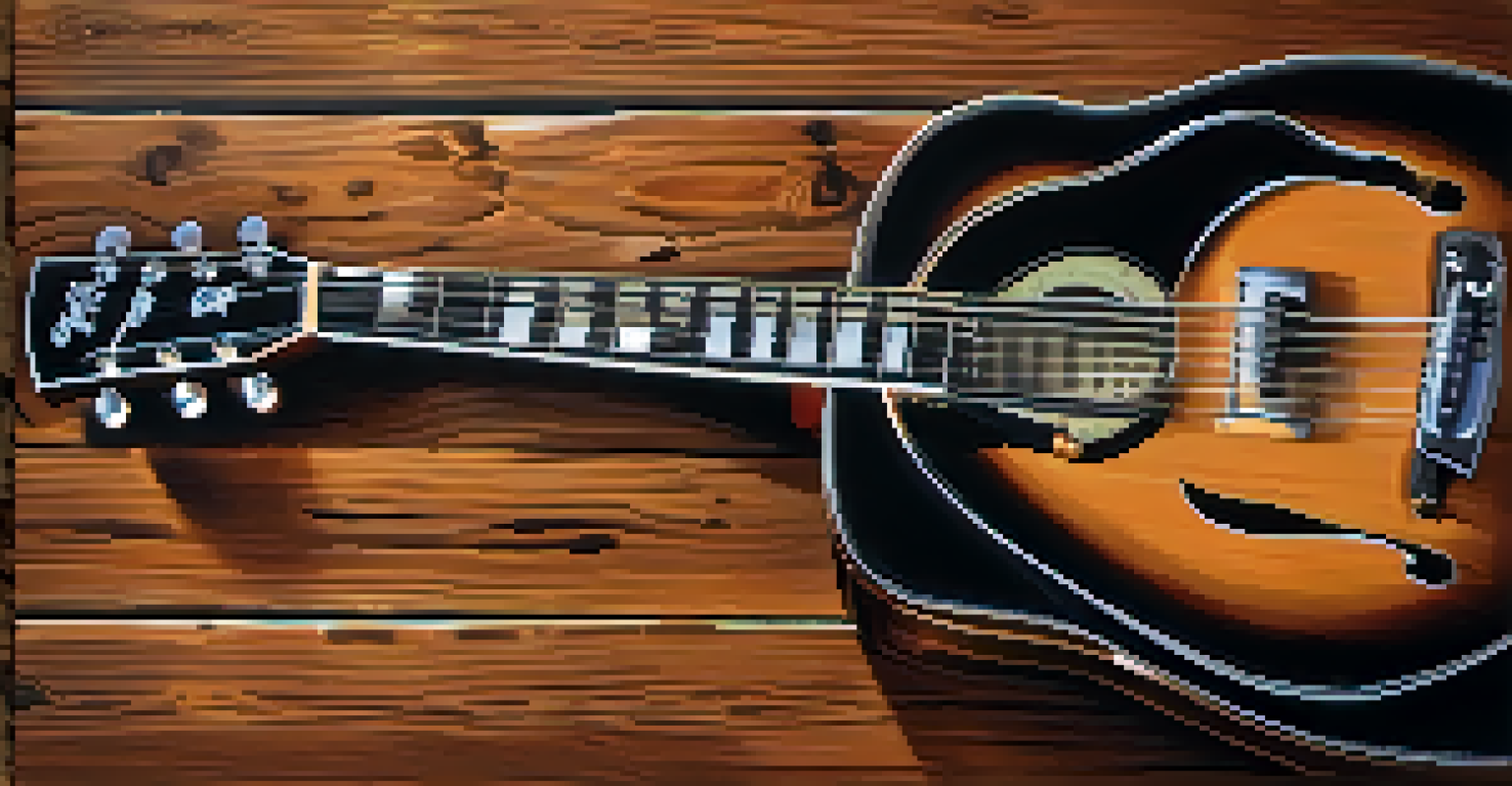The Symbolism of Guitar Sounds in Film Narratives

Guitar Sounds: The Heartbeat of Film Emotion
Guitar sounds often serve as an emotional anchor in films, resonating with viewers on a deeper level. When a character experiences joy, melancholy, or tension, the guitar's unique tones can amplify these feelings, making them more visceral. For instance, a gentle acoustic guitar strumming can evoke nostalgia, while a distorted electric guitar might signal chaos or conflict. This emotional resonance allows filmmakers to create a more immersive experience for the audience.
Music can change the world because it can change people.
Consider iconic films like 'The Shawshank Redemption,' where the acoustic guitar plays a pivotal role in expressing hope amidst despair. The subtle strumming during crucial scenes enhances the narrative, drawing viewers closer to the characters' emotional journeys. By connecting the audience with the guitar's sound, filmmakers can effectively convey complex emotions without relying solely on dialogue.
Thus, the guitar becomes more than just a musical instrument; it transforms into a narrative tool that shapes the film's emotional landscape. This symbolic use of guitar sounds enriches the storytelling, making the audience feel more connected to the characters and their experiences.
Cultural Context: Guitar Sounds Across Genres
The symbolism of guitar sounds varies significantly across different film genres and cultural contexts. In Westerns, for example, a lone guitar often signifies solitude and the rugged individualism of the cowboy archetype. Conversely, in romantic comedies, sweet, melodic guitar tunes can symbolize love and connection, enhancing the film's light-hearted moments. This diversity in representation highlights how the guitar adapts its symbolism to fit the narrative's cultural backdrop.

Moreover, the genre influences the emotional weight of the guitar sounds. In horror films, dissonant guitar riffs can create an unsettling atmosphere, heightening tension and fear. In contrast, in a coming-of-age film, upbeat guitar melodies might signify growth and freedom, illustrating the characters' journey. This genre-specific approach allows filmmakers to use guitar sounds as a versatile tool in their storytelling arsenal.
Guitar Sounds Amplify Film Emotion
Guitar sounds act as emotional anchors in films, enhancing the viewer's connection to characters' experiences.
Ultimately, understanding the cultural context surrounding guitar sounds in film narratives enables viewers to appreciate the deeper layers of meaning embedded in the soundtrack. It shows how filmmakers intentionally craft soundscapes that resonate with the audience, enriching the overall cinematic experience.
Character Development: Guitars as Identity Markers
Guitars often serve as identity markers for characters, revealing their personalities and backgrounds. A character who plays a classic acoustic guitar might be portrayed as introspective and sensitive, while one wielding an electric guitar could embody rebellion and passion. This distinction allows viewers to glean insights into a character's journey through their musical choices, adding depth to their development.
The power of music is such that it can bring back memories, evoke emotions, and transport us to another time and place.
For example, in films like 'A Star is Born,' the guitar becomes a symbol of the protagonist's struggles and aspirations. As the character evolves, so does their relationship with the guitar, mirroring their emotional highs and lows. This connection between character development and guitar sounds provides a unique lens through which audiences can understand the characters' motivations and transformations.
By using guitars as identity markers, filmmakers create a rich tapestry of character exploration. The guitar thus becomes a vital component of storytelling, as it encapsulates the essence of who the character is and what they represent in the narrative.
Symbolism of Guitar Sounds in Cinematic Themes
Guitar sounds often embody larger themes within a film, acting as a sonic representation of core ideas. For instance, the use of a haunting guitar theme can symbolize loss and longing, echoing the film's exploration of grief. This thematic resonance enhances the audience's understanding of the narrative, as they connect the sound to the characters' experiences and struggles.
In films centered around journey and discovery, the guitar can represent freedom and adventure. The uplifting strums of a guitar might accompany a character's pivotal moments of self-discovery, reinforcing the theme of personal growth. This alignment between sound and theme enriches the storytelling, providing viewers with a multifaceted experience that resonates on both emotional and intellectual levels.
Guitars as Identity Markers
Guitars symbolize character identities, revealing their personalities and emotional journeys through musical choices.
Therefore, the symbolism of guitar sounds transcends mere background music, becoming integral to the film's thematic exploration. By weaving these sounds into the narrative, filmmakers create a cohesive experience that invites viewers to engage with the story on multiple levels.
The Role of Guitarists in Film Soundtracks
Guitarists play a crucial role in shaping film soundtracks, often bringing their unique styles and interpretations to the project. Their expertise can infuse the score with authenticity and emotional depth, enhancing the overall impact of the film. Famous guitarists, like Rodrigo y Gabriela, have contributed to soundtracks in ways that elevate the narrative, making their presence felt long after the credits roll.
The collaboration between filmmakers and guitarists is a delicate dance, where both parties work together to ensure that the music aligns with the film's vision. This partnership can lead to iconic moments in cinema, where the guitar sounds become as memorable as the visuals. Consider the use of guitar in Quentin Tarantino's films; the carefully chosen riffs often become signature elements that define the movie's tone.
In essence, guitarists are not just musicians; they are storytellers in their own right. Through their craft, they help to weave the narrative threads together, making the guitar an indispensable part of the film's emotional fabric.
Guitar Sounds in Iconic Movie Scenes
Certain movie scenes are forever etched in our memories thanks to the powerful guitar sounds that accompany them. Think of the iconic moment in 'Pulp Fiction' when the smooth guitar riff enhances the tension during the dance scene. This perfect marriage of visuals and music creates an unforgettable cinematic experience, illustrating how guitar sounds can elevate a scene to legendary status.
Similarly, in 'The Graduate,' the iconic use of Simon & Garfunkel's guitar-driven songs captures the essence of youthful disillusionment. The gentle guitar melodies resonate with the protagonist's inner turmoil, making the scenes more impactful and relatable. These examples show how filmmakers strategically use guitar sounds to create iconic moments that resonate with audiences long after they leave the theater.
Guitarists Shape Film Soundtracks
Collaboration between filmmakers and guitarists enriches film soundtracks, making guitar sounds integral to storytelling.
Ultimately, the integration of guitar sounds into these pivotal scenes underscores their role as powerful storytelling tools. They not only enhance the emotional depth but also establish a lasting connection between the film and its viewers, solidifying the guitar's place in cinematic history.
The Evolution of Guitar Sounds in Film
The role of guitar sounds in film has evolved significantly over the decades, adapting to changes in technology and audience preferences. Early films often relied on live guitar performances to set the mood, while modern cinema utilizes a blend of recorded sounds and digital manipulation to create immersive soundscapes. This evolution reflects the broader shifts in the music industry and the ways in which filmmakers seek to engage audiences.
As genres have diversified, so too have the uses of guitar sounds in film. Today, filmmakers explore various styles, from folk and rock to jazz and electronic, allowing for a richer palette of sounds that enhance storytelling. This breadth of musical influence enables the guitar to adapt its symbolism, aligning with contemporary themes and character arcs in innovative ways.

In conclusion, the evolution of guitar sounds in film not only reflects changes in technology but also highlights the enduring power of music in storytelling. As filmmakers continue to experiment and redefine the role of the guitar, its symbolism will likely evolve, enriching the cinematic landscape for future generations.
Conclusion: The Lasting Impact of Guitar Sounds in Film
The symbolism of guitar sounds in film narratives is a rich and multifaceted topic that reveals much about the art of storytelling. From enhancing emotional depth to marking character identities and thematic explorations, guitar sounds have left an indelible mark on cinema. As viewers, understanding these nuances allows us to appreciate the film's soundscapes as integral components of the narrative.
Moreover, the guitar's adaptability across genres and cultural contexts showcases its universality as a storytelling tool. Whether it's the soulful strumming of an acoustic guitar or the electrifying riffs of rock, the guitar resonates with audiences in profound ways. This connection between sound and story is what makes film a powerful medium for emotional expression.
In summary, the lasting impact of guitar sounds in film is a testament to their symbolic significance. As filmmakers continue to harness the power of the guitar, audiences can look forward to experiencing more captivating narratives that resonate on multiple levels, ensuring that the guitar remains a beloved symbol in the world of cinema.